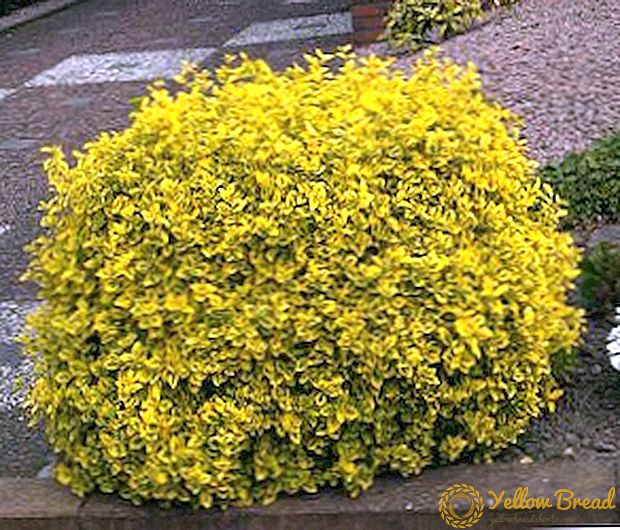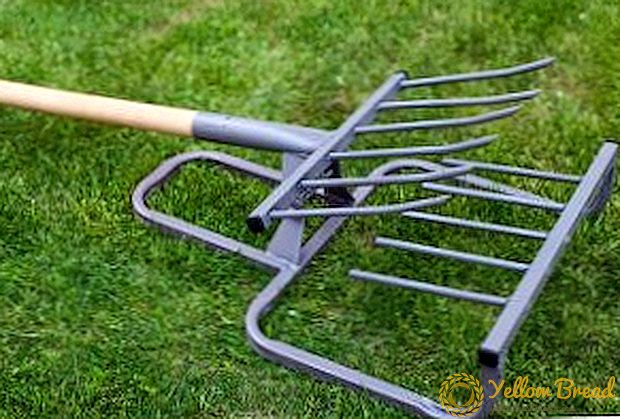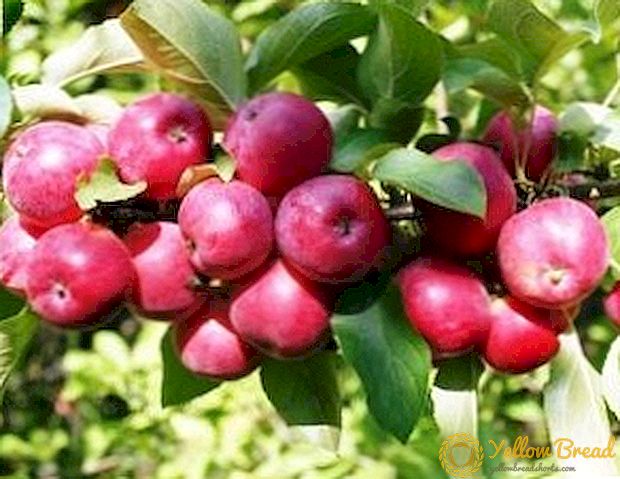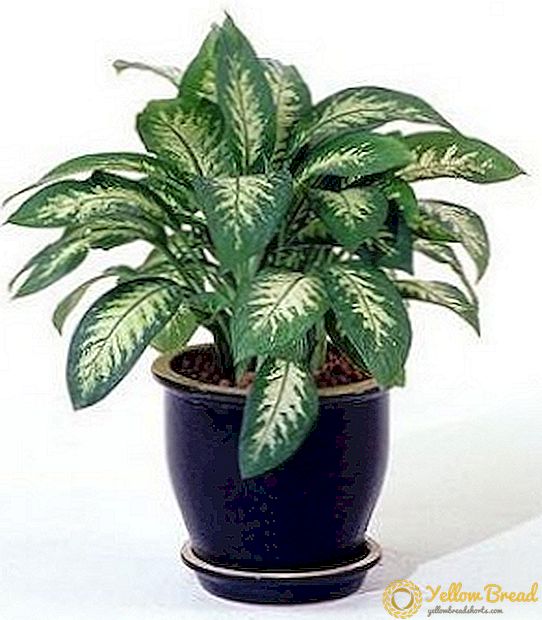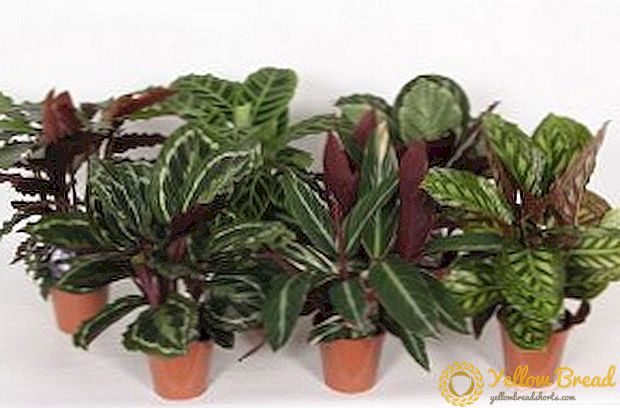 When growing tomatoes in greenhouses, watering is one of the most important agronomic measures. It is on whether you water the vegetable plants correctly that their safe growth and good harvest depend. On the basis of observations, gardeners developed a number of recommendations on how and when it is best to water the tomatoes in the greenhouse, and what level of humidity is necessary for their normal growth. In the article we share them with you.
When growing tomatoes in greenhouses, watering is one of the most important agronomic measures. It is on whether you water the vegetable plants correctly that their safe growth and good harvest depend. On the basis of observations, gardeners developed a number of recommendations on how and when it is best to water the tomatoes in the greenhouse, and what level of humidity is necessary for their normal growth. In the article we share them with you.
- Features microclimate greenhouses
- Basics of high-quality irrigation of tomatoes
- The norms of soil moisture and air for tomatoes
- Crop dependence of irrigation
- Yield quality depending on irrigation
- Watering tomatoes in the greenhouse, depending on the phase of plant growth
- When planting seedlings
- Active plant growth
- In the period of fruit set
- When ripe tomatoes
- Types of watering organization
- Manual
- Drip
- Auto
- Favorable time of day for watering
- Excessive moisture and its lack
- Recommendations and tips from experienced gardeners
Features microclimate greenhouses
Before delving into the nuances of watering tomatoes, we suggest to deal with the microclimatic features of greenhouses.  In summer, in normal weather, the humidity in the greenhouse ranges from 60 to 80%. If the weather is dry and too hot for a long time, then the mark on the hygrometer can drop to 40%. If the heat alternates with rains, then this figure can go up to 90%.
In summer, in normal weather, the humidity in the greenhouse ranges from 60 to 80%. If the weather is dry and too hot for a long time, then the mark on the hygrometer can drop to 40%. If the heat alternates with rains, then this figure can go up to 90%.
Tomatoes are demanding of moisture, but they do not accept strong humidity. The aboveground part of the vegetable culture develops better in dry air.  For some reason, there is such a widespread belief that a lot of moisture is also needed for tomato roots. However, it is erroneous. It is important not to overdo it with watering, and not to leave plants for long without life-giving moisture.
For some reason, there is such a widespread belief that a lot of moisture is also needed for tomato roots. However, it is erroneous. It is important not to overdo it with watering, and not to leave plants for long without life-giving moisture.
The excess water is likely to affect the roots - they will rot.The lack of moisture will lead to poor development of the culture, small fruits, drying of the foliage and even death of the plants from overheating.
Basics of high-quality irrigation of tomatoes
High-quality watering of tomatoes will depend on:
- watering frequency;
- strict adherence to recommended standards for maintaining soil moisture and air;
- compliance with the required frequency of irrigation;
- following the recommended volume of water applied to each bush;
- choosing the right method and time of making moisture;
- watering with water of the recommended temperature.

The norms of soil moisture and air for tomatoes
For normal growth of vegetable culture, it is necessary that after wetting the soil moisture reaches 90%, and the air humidity reaches 50-60%. Creating such conditions, it is possible to ensure the proper development of the plant and its protection from the development of fungal infections.
To achieve such conditions, it is necessary to know how often it is recommended to water the tomatoes in the greenhouse.
In this case, under each bush should be poured from four to five liters of water.  Advice on how many times to water tomatoes, suitable for growing tomatoes in closed ground as a whole and does not depend on whether it is carried out in a greenhouse made of polycarbonate or from another material.
Advice on how many times to water tomatoes, suitable for growing tomatoes in closed ground as a whole and does not depend on whether it is carried out in a greenhouse made of polycarbonate or from another material.
Water should not fall on the leaves and shoots - this is fraught with the development of diseases and burns. After all, falling on the droplets, the sun's rays will burn the plant's organs.
Crop dependence of irrigation
If you are interested in the cultivation of tomatoes in the greenhouse, you already understand that a successful harvest depends on the observance of several factors: proper lighting, temperature, the presence of minerals and water.  It is water that takes part in all processes in the plant. Its presence in sufficient quantities in the cells - at the level of 80-90% - guarantees the normal course of physiological processes, in particular, and the distribution of nutrients to all organs of the vegetable culture.
It is water that takes part in all processes in the plant. Its presence in sufficient quantities in the cells - at the level of 80-90% - guarantees the normal course of physiological processes, in particular, and the distribution of nutrients to all organs of the vegetable culture.
Such a high rate suggests that the plant should receive water without interruption.
Its lack leads to the fact that the processes of photosynthesis are disturbed, mineral substances are incorrectly distributed and can become not useful, but harmful, having a stronger effect than necessary. The plant stops growing, and the fruits are not tied.
Proper and regular irrigation of tomatoes must be adjusted, as it directly affects the volume and quality of the crop.  For example, improperly adjusted moisture immediately after planting and in the early stages will inevitably lead to the fact that seedlings will develop poorly, some may not live to fruition at all.
For example, improperly adjusted moisture immediately after planting and in the early stages will inevitably lead to the fact that seedlings will develop poorly, some may not live to fruition at all.
Excessive moistening at this time is fraught with a strong growth of the ground part, while the root system will remain underdeveloped and will not cope with the task of feeding the whole plant and building fruit. The plant will weaken, drop flowers or bear small fruits.
Yield quality depending on irrigation
Of course, the quality of the harvest also directly depends on the degree and regularity of wetting the vegetable in the process of growth and development.
The lack of moisture leads to poor fruiting, as well as the formation of small fruits. The excess and abundance of moisture during the fruiting period provoke the cracking of ripe fruits. 
Watering tomatoes in the greenhouse, depending on the phase of plant growth
Above, we looked at how to water the tomatoes in the greenhouse. In this section, we suggest that you familiarize yourself with the recommendations on the mode of application of moisture, depending on the stage of plant development.
If you look at the amount of water that is contained in the cells of young bushes, then it will be 92-95%. Fruiting plants contain from 85 to 90% water. Thus, the replenishment of moisture will increasingly require young planting.
During ripening, watering will need to be reduced. We propose to consider in more detail the norms of how to water the tomatoes in the greenhouse, depending on the phase of their development. 
When planting seedlings
After planting seedlings in closed ground, she will need frequent, but not abundant moisture. At this time, young bushes are still poorly developed root system, and the plant itself is in a depressed state after changing the place and conditions of growth.
A sufficient supply of moisture during this period is the main condition for the adaptation of young tomatoes and the development of their root system.
It should be remembered that poorly developed roots are still not able to absorb large amounts of water, so it is better to water them more often: daily, but in small doses, 2-3 liters per bush.
The main rule at this time is the regular entry of moisture and the elimination of its stagnation in the upper layer of the soil. 
Active plant growth
After the stem has adapted well to the soil and has begun to grow actively, the irrigation regime will need to be changed. At this time, the above-ground organs of the vegetable culture grow intensively, new shoots appear. Therefore, moisture should be enough to feed them.
From this point on, it is necessary to switch to not too frequent watering - once or twice a week (preferably no more than once every five days), but abundant. The fact that the plants need to be watered will be indicated by the drying of the top layer of soil by 3-5 cm.
If you leave the previous mode, then frequent moistening will lead to the fact that the plants will form a surface root system that can not feed all the green mass and fruits. 
In the period of fruit set
Watering tomatoes during the flowering and fruit set in the greenhouse is very important. Since both an overabundance and lack of moisture at this moment can provoke a fall of flowers and poor formation of the ovary.
At this time, you can adhere to the regime: once every seven days and consumption; 10 liters per 1 square. m or 5 liters per bush.
When ripe tomatoes
From the beginning of the reddening of the fruit, tomatoes will no longer need moisture as they used to.  If you do not change the mode of irrigation at this time, it is fraught with the fact that the fruits accumulate an excessive amount of moisture, and they lose their taste and aromatic qualities.
If you do not change the mode of irrigation at this time, it is fraught with the fact that the fruits accumulate an excessive amount of moisture, and they lose their taste and aromatic qualities.
Therefore, the frequency of proper irrigation of tomatoes during fruiting in the greenhouse - once in 8-10 days. Volume - 10-12 liters per 1 square. m., depending on the state of the plants.
The upper fruits in July-August are at the stage of final maturation. And most of the leaves on the bushes have already fallen. In this period, the amount of moisture should be reduced to 8 liters per 1 square. m  It is important when watering tomatoes in August in the greenhouse not to overwet them, otherwise the fruit will be watery, cracked, tasteless and unsuitable for transportation.
It is important when watering tomatoes in August in the greenhouse not to overwet them, otherwise the fruit will be watery, cracked, tasteless and unsuitable for transportation.
The ripening of most fruits in the upper part of the bushes is the time when watering tomatoes in the greenhouse should be stopped.
Types of watering organization
Watering tomatoes in the greenhouse can be in several ways:
- Manual - using a watering can, bucket, hose;
- Drip - using a drip system, plastic bottles;
- Automatically.
Manual
When choosing a method for moistening the soil, it is necessary to remember that tomatoes need only watering at the root, water should not fall on the above-ground part. Therefore, when using for irrigation watering can spray with her to remove.  This method is ancient, but not very convenient, especially for the elderly, as it is associated with weight-liftings. Nevertheless, with the help of this method it is good to control the volume of water that pours out under each bush.
This method is ancient, but not very convenient, especially for the elderly, as it is associated with weight-liftings. Nevertheless, with the help of this method it is good to control the volume of water that pours out under each bush.
Also, the volume of water is well controlled when irrigating with a bucket. The bucket should be comfortable and fit the required dosage.This method is also associated with considerable physical exertion and is fraught with the appearance of a crust on the soil surface. Soil with this watering must be mulched.
Hosing is good for large areas. This is the most common method used by summer residents.
However, he also has a number of disadvantages:
- the inability to control the amount of water applied;
- the likelihood of damage to landings when it is tied from bush to bush;
- the inability to water with warm water;
- formation after watering the crust on the surface of the soil.
 It is important to remember that when using a hose, the method of sprinkling for tomatoes is strictly prohibited.
It is important to remember that when using a hose, the method of sprinkling for tomatoes is strictly prohibited.Drip
The best way for tomatoes is drip. The budget version of its organization - with the help of plastic bottles. At these tanks the bottom is cut off, and two to four holes with a diameter of 1-2 mm are made in the covers.
The advantages of this method:
- less water consumption than when moistened with a hose, a bucket or a watering can, because water flows directly to the roots;
- air humidity does not rise, since water immediately goes under the soil;
- reducing the risk of fungal diseases in vegetables;
- simplicity in performance and accessibility.
 Drip irrigation is also carried out using a special system.
Drip irrigation is also carried out using a special system.- economical water consumption;
- yield increase;
- prevention of soil salinization and leaching of nutrients from it;
- small time and labor costs;
- possibility of watering at any time.

Auto
Automatic irrigation is expensive and, as a rule, used in the industrial cultivation of tomatoes.However, for owners of polycarbonate greenhouses - this is also a great way to establish automated watering throughout the growing season in tomatoes and their fruiting.
Automated systems can irrigate several types: sprinkling, drip, and subsurface. The first is not suitable for tomatoes. Systems can be purchased as a finished product, and make his own.
The advantages of automatic irrigation:
- one hundred percent moisture to the roots;
- reducing the risk of disease in plants;
- availability of a programmable timer that regulates the time of water supply and its volume;
- uninterrupted water supply;
- uniform distribution of moisture;
- autonomy of the system allows the use of water of the desired temperature;
- minimum cost of manual labor.

Favorable time of day for watering
With regard to the recommended time for watering, then water the tomatoes in the greenhouse should be early in the morning or in the evening. At this time of day, the sun will not be able to create a greenhouse effect, and water will be completely absorbed by the roots, and not evaporate, causing an increase in humidity.
If possible, then give preference to morning watering, an hour or two after sunrise. Evening watering, especially at a later time, is fraught with the development of diseases. In addition, the peak of moisture consumption by plants occurs in the period from noon to two in the afternoon.

Excessive moisture and its lack
Of course, any plant, if it is cared for incorrectly, will signal its owner with changes in appearance. So, the first sign of a lack of moisture is twisting of the leaves along the central vein.
It is important to understand that with a lack of moisture, plants will not tolerate air temperatures of +30 ° C and higher. They will overheat.
When the first signs of a lack of moisture appear, you should not immediately flood the plants abundantly. The establishment of the correct mode of watering should occur gradually. Remember that the main thing is not so much the frequency as the regularity and volume of the applied fluid.  If the leaves are drying out, then simultaneously with the restoration of proper moisture, it is also necessary to take care of making additional feeding.
If the leaves are drying out, then simultaneously with the restoration of proper moisture, it is also necessary to take care of making additional feeding.
The excess moisture first thing will affect the roots and lower parts of the stems, they will rot. If you notice this trend, then the volume and frequency of hydration will need to be reduced.
Too much moisture during fruiting will result in cracked fruits and a reduction in their palatability.

Recommendations and tips from experienced gardeners
- If the tank with water for irrigation is located directly in the greenhouse, it should be covered with plastic wrap or a lid so as not to create additional evaporation and an unnecessary increase in air humidity.
- When water is slowly absorbed into the soil, the ground under a bush should be pierced with forks in several places.
- After watering in the greenhouse, you need to open all the vents and doors to establish good air circulation. The key to proper maintenance of greenhouse tomatoes are frequent airing and mandatory airing after watering.
- After irrigation, loosening the soil is not recommended. The best option would be mulching with straw or dry grass.
- The temperature of the water that you need to water the tomatoes: in the warm season - 18-20 degrees, in the cold - 22-24 degrees.
 Tomatoes are warm and moisture-loving plants that can be planted in both open and closed ground. One of the important and basic measures to care for them is regular and abundant watering.
Tomatoes are warm and moisture-loving plants that can be planted in both open and closed ground. One of the important and basic measures to care for them is regular and abundant watering.The frequency of supply and the abundance of moisture will depend on the variety of tomatoes, the phase of plant development, weather conditions, climatic zone.The quantity and quality of the crop directly depends on the proper moistening.

